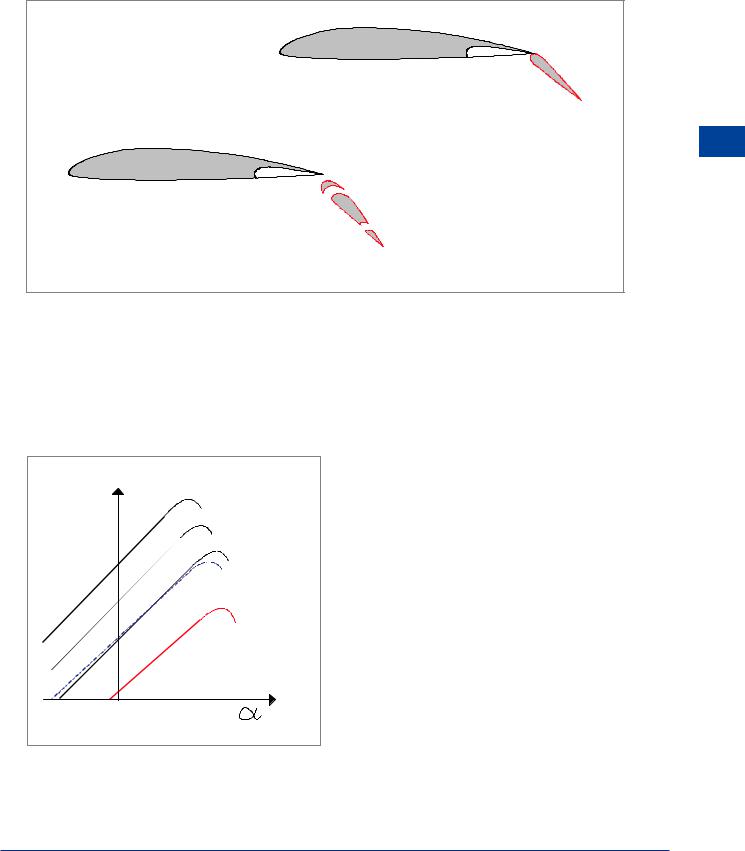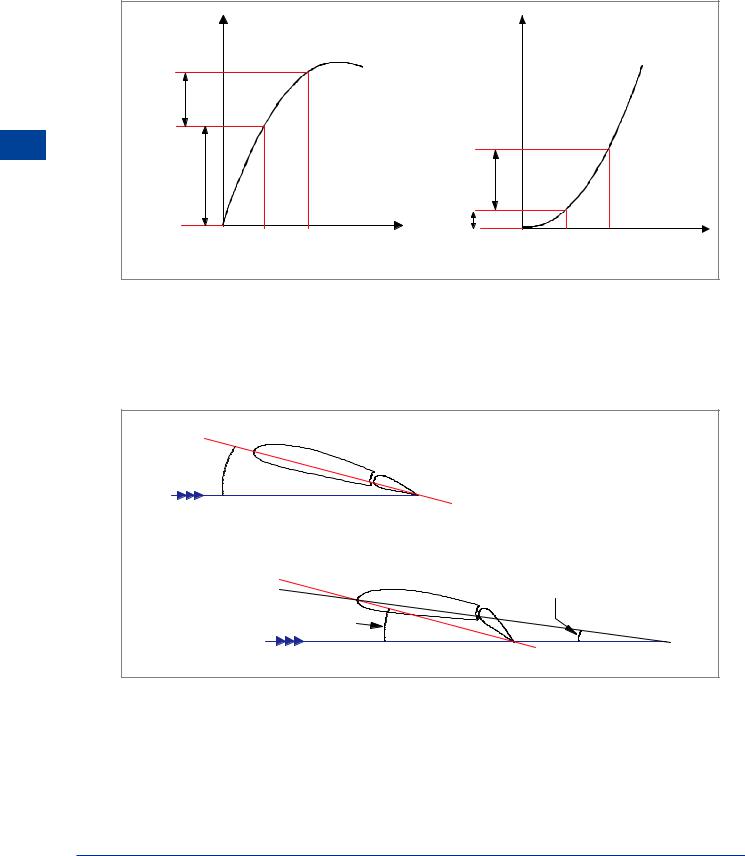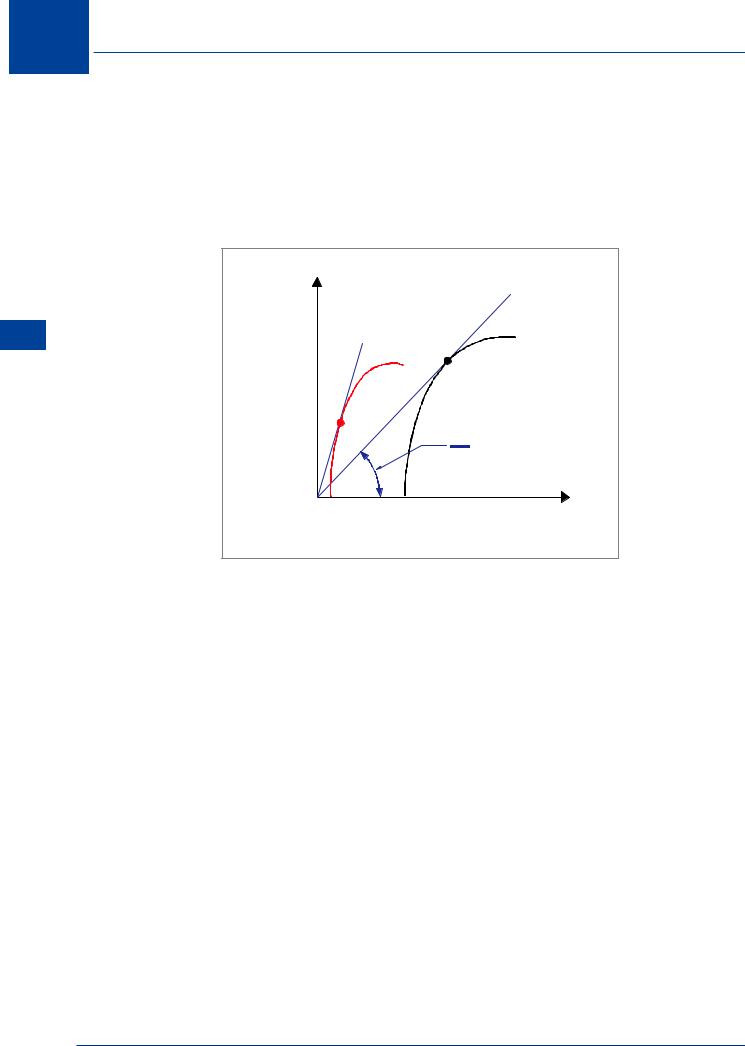
- •Textbook Series
- •Contents
- •1 Overview and Definitions
- •Overview
- •General Definitions
- •Glossary
- •List of Symbols
- •Greek Symbols
- •Others
- •Self-assessment Questions
- •Answers
- •2 The Atmosphere
- •Introduction
- •The Physical Properties of Air
- •Static Pressure
- •Temperature
- •Air Density
- •International Standard Atmosphere (ISA)
- •Dynamic Pressure
- •Key Facts
- •Measuring Dynamic Pressure
- •Relationships between Airspeeds
- •Airspeed
- •Errors and Corrections
- •V Speeds
- •Summary
- •Questions
- •Answers
- •3 Basic Aerodynamic Theory
- •The Principle of Continuity
- •Bernoulli’s Theorem
- •Streamlines and the Streamtube
- •Summary
- •Questions
- •Answers
- •4 Subsonic Airflow
- •Aerofoil Terminology
- •Basics about Airflow
- •Two Dimensional Airflow
- •Summary
- •Questions
- •Answers
- •5 Lift
- •Aerodynamic Force Coefficient
- •The Basic Lift Equation
- •Review:
- •The Lift Curve
- •Interpretation of the Lift Curve
- •Density Altitude
- •Aerofoil Section Lift Characteristics
- •Introduction to Drag Characteristics
- •Lift/Drag Ratio
- •Effect of Aircraft Weight on Minimum Flight Speed
- •Condition of the Surface
- •Flight at High Lift Conditions
- •Three Dimensional Airflow
- •Wing Terminology
- •Wing Tip Vortices
- •Wake Turbulence: (Ref: AIC P 072/2010)
- •Ground Effect
- •Conclusion
- •Summary
- •Answers from page 77
- •Answers from page 78
- •Questions
- •Answers
- •6 Drag
- •Introduction
- •Parasite Drag
- •Induced Drag
- •Methods of Reducing Induced Drag
- •Effect of Lift on Parasite Drag
- •Aeroplane Total Drag
- •The Effect of Aircraft Gross Weight on Total Drag
- •The Effect of Altitude on Total Drag
- •The Effect of Configuration on Total Drag
- •Speed Stability
- •Power Required (Introduction)
- •Summary
- •Questions
- •Annex C
- •Answers
- •7 Stalling
- •Introduction
- •Cause of the Stall
- •The Lift Curve
- •Stall Recovery
- •Aircraft Behaviour Close to the Stall
- •Use of Flight Controls Close to the Stall
- •Stall Recognition
- •Stall Speed
- •Stall Warning
- •Artificial Stall Warning Devices
- •Basic Stall Requirements (EASA and FAR)
- •Wing Design Characteristics
- •The Effect of Aerofoil Section
- •The Effect of Wing Planform
- •Key Facts 1
- •Super Stall (Deep Stall)
- •Factors that Affect Stall Speed
- •1g Stall Speed
- •Effect of Weight Change on Stall Speed
- •Composition and Resolution of Forces
- •Using Trigonometry to Resolve Forces
- •Lift Increase in a Level Turn
- •Effect of Load Factor on Stall Speed
- •Effect of High Lift Devices on Stall Speed
- •Effect of CG Position on Stall Speed
- •Effect of Landing Gear on the Stall Speed
- •Effect of Engine Power on Stall Speed
- •Effect of Mach Number (Compressibility) on Stall Speed
- •Effect of Wing Contamination on Stall Speed
- •Warning to the Pilot of Icing-induced Stalls
- •Stabilizer Stall Due to Ice
- •Effect of Heavy Rain on Stall Speed
- •Stall and Recovery Characteristics of Canards
- •Spinning
- •Primary Causes of a Spin
- •Phases of a Spin
- •The Effect of Mass and Balance on Spins
- •Spin Recovery
- •Special Phenomena of Stall
- •High Speed Buffet (Shock Stall)
- •Answers to Questions on Page 173
- •Key Facts 2
- •Questions
- •Key Facts 1 (Completed)
- •Key Facts 2 (Completed)
- •Answers
- •8 High Lift Devices
- •Purpose of High Lift Devices
- •Take-off and Landing Speeds
- •Augmentation
- •Flaps
- •Trailing Edge Flaps
- •Plain Flap
- •Split Flap
- •Slotted and Multiple Slotted Flaps
- •The Fowler Flap
- •Comparison of Trailing Edge Flaps
- •and Stalling Angle
- •Drag
- •Lift / Drag Ratio
- •Pitching Moment
- •Centre of Pressure Movement
- •Change of Downwash
- •Overall Pitch Change
- •Aircraft Attitude with Flaps Lowered
- •Leading Edge High Lift Devices
- •Leading Edge Flaps
- •Effect of Leading Edge Flaps on Lift
- •Leading Edge Slots
- •Leading Edge Slat
- •Automatic Slots
- •Disadvantages of the Slot
- •Drag and Pitching Moment of Leading Edge Devices
- •Trailing Edge Plus Leading Edge Devices
- •Sequence of Operation
- •Asymmetry of High Lift Devices
- •Flap Load Relief System
- •Choice of Flap Setting for Take-off, Climb and Landing
- •Management of High Lift Devices
- •Flap Extension Prior to Landing
- •Questions
- •Annexes
- •Answers
- •9 Airframe Contamination
- •Introduction
- •Types of Contamination
- •Effect of Frost and Ice on the Aircraft
- •Effect on Instruments
- •Effect on Controls
- •Water Contamination
- •Airframe Aging
- •Questions
- •Answers
- •10 Stability and Control
- •Introduction
- •Static Stability
- •Aeroplane Reference Axes
- •Static Longitudinal Stability
- •Neutral Point
- •Static Margin
- •Trim and Controllability
- •Key Facts 1
- •Graphic Presentation of Static Longitudinal Stability
- •Contribution of the Component Surfaces
- •Power-off Stability
- •Effect of CG Position
- •Power Effects
- •High Lift Devices
- •Control Force Stability
- •Manoeuvre Stability
- •Stick Force Per ‘g’
- •Tailoring Control Forces
- •Longitudinal Control
- •Manoeuvring Control Requirement
- •Take-off Control Requirement
- •Landing Control Requirement
- •Dynamic Stability
- •Longitudinal Dynamic Stability
- •Long Period Oscillation (Phugoid)
- •Short Period Oscillation
- •Directional Stability and Control
- •Sideslip Angle
- •Static Directional Stability
- •Contribution of the Aeroplane Components.
- •Lateral Stability and Control
- •Static Lateral Stability
- •Contribution of the Aeroplane Components
- •Lateral Dynamic Effects
- •Spiral Divergence
- •Dutch Roll
- •Pilot Induced Oscillation (PIO)
- •High Mach Numbers
- •Mach Trim
- •Key Facts 2
- •Summary
- •Questions
- •Key Facts 1 (Completed)
- •Key Facts 2 (Completed)
- •Answers
- •11 Controls
- •Introduction
- •Hinge Moments
- •Control Balancing
- •Mass Balance
- •Longitudinal Control
- •Lateral Control
- •Speed Brakes
- •Directional Control
- •Secondary Effects of Controls
- •Trimming
- •Questions
- •Answers
- •12 Flight Mechanics
- •Introduction
- •Straight Horizontal Steady Flight
- •Tailplane and Elevator
- •Balance of Forces
- •Straight Steady Climb
- •Climb Angle
- •Effect of Weight, Altitude and Temperature.
- •Power-on Descent
- •Emergency Descent
- •Glide
- •Rate of Descent in the Glide
- •Turning
- •Flight with Asymmetric Thrust
- •Summary of Minimum Control Speeds
- •Questions
- •Answers
- •13 High Speed Flight
- •Introduction
- •Speed of Sound
- •Mach Number
- •Effect on Mach Number of Climbing at a Constant IAS
- •Variation of TAS with Altitude at a Constant Mach Number
- •Influence of Temperature on Mach Number at a Constant Flight Level and IAS
- •Subdivisions of Aerodynamic Flow
- •Propagation of Pressure Waves
- •Normal Shock Waves
- •Critical Mach Number
- •Pressure Distribution at Transonic Mach Numbers
- •Properties of a Normal Shock Wave
- •Oblique Shock Waves
- •Effects of Shock Wave Formation
- •Buffet
- •Factors Which Affect the Buffet Boundaries
- •The Buffet Margin
- •Use of the Buffet Onset Chart
- •Delaying or Reducing the Effects of Compressibility
- •Aerodynamic Heating
- •Mach Angle
- •Mach Cone
- •Area (Zone) of Influence
- •Bow Wave
- •Expansion Waves
- •Sonic Bang
- •Methods of Improving Control at Transonic Speeds
- •Questions
- •Answers
- •14 Limitations
- •Operating Limit Speeds
- •Loads and Safety Factors
- •Loads on the Structure
- •Load Factor
- •Boundary
- •Design Manoeuvring Speed, V
- •Effect of Altitude on V
- •Effect of Aircraft Weight on V
- •Design Cruising Speed V
- •Design Dive Speed V
- •Negative Load Factors
- •The Negative Stall
- •Manoeuvre Boundaries
- •Operational Speed Limits
- •Gust Loads
- •Effect of a Vertical Gust on the Load Factor
- •Effect of the Gust on Stalling
- •Operational Rough-air Speed (V
- •Landing Gear Speed Limitations
- •Flap Speed Limit
- •Aeroelasticity (Aeroelastic Coupling)
- •Flutter
- •Control Surface Flutter
- •Aileron Reversal
- •Questions
- •Answers
- •15 Windshear
- •Introduction (Ref: AIC 84/2008)
- •Microburst
- •Windshear Encounter during Approach
- •Effects of Windshear
- •“Typical” Recovery from Windshear
- •Windshear Reporting
- •Visual Clues
- •Conclusions
- •Questions
- •Answers
- •16 Propellers
- •Introduction
- •Definitions
- •Aerodynamic Forces on the Propeller
- •Thrust
- •Centrifugal Twisting Moment (CTM)
- •Propeller Efficiency
- •Variable Pitch Propellers
- •Power Absorption
- •Moments and Forces Generated by a Propeller
- •Effect of Atmospheric Conditions
- •Questions
- •Answers
- •17 Revision Questions
- •Questions
- •Answers
- •Explanations to Specimen Questions
- •Specimen Examination Paper
- •Answers to Specimen Exam Paper
- •Explanations to Specimen Exam Paper
- •18 Index

High Lift Devices |
|
8 |
|
||
|
|
|
The Fowler Flap
The Fowler flap, Figure 8.4, moves rearwards and then down, initially giving an increase in wing area and then an increase in camber. The Fowler flap may be slotted.
|
|
|
Fowler |
Flap |
|
|
|
|
8 |
|
|
|
|
High Lift Devices |
Triple |
Slotted |
Fowler |
Flap |
|
|
|
|
Figure 8.4 |
|
Because of the combined effects of increased area and camber, the Fowler flap gives the greatest increase in lift of the flaps considered and also gives the least drag because of the slot and the reduction of thickness : chord ratio. However, the change of pitching moment is greater because of the rearward extension of the chord.
Comparison of Trailing Edge Flaps
|
FOWLER FLAP |
CL |
SLOTTED FLAP |
|
|
|
SPLIT FLAP |
|
PLAIN FLAP |
|
BASIC SECTION |
Figure 8.5 shows a comparison of the lift curves for the flaps considered above, for the same angle of flap deflection. It should be noted, however, that the different types of flap do not all give their greatest increase in lift at the same flap angle.
Figure 8.5
211

8 |
|
High Lift Devices |
|
||
|
|
|
Figure 8.6 shows the variation of the lift increment with flap angle and the variation of drag increment with flap angle. It can be seen that the increment in lift is decreasing and the increment in drag is increasing as flaps are deployed. It is important to note that any amount of flap increases drag.
|
|
CL |
|
|
CD |
|
|
5º |
TO |
10º |
|
|
|
|
|
8 |
|
|
|
|
|
|
|
High |
0º |
TO 5º |
|
5º |
TO 10º |
|
|
Lift |
|
0º |
5º |
10º |
|
|
|
Devices |
|
TO 5º |
|
|
|||
|
|
|
|
0º |
|
|
|
|
|
|
|
|
0º |
5º |
10º |
|
|
|
|
FLAP ANGLE |
|
|
FLAP ANGLE |
Figure 8.6
CLMAX and Stalling Angle
It can be seen from Figure 8.5 that with the flap lowered CLMAX is increased, but the stalling angle is reduced. This is because lowering the flap increases the effective angle of attack.
REDUCED ANGLE OF ATTACK |
OF BASIC SECTION |
EFFECTIVE |
ANGLE OF ATTACK |
Figure 8.7
It is conventional to plot the CL ~ α curve using the angle of attack for the basic section. Consequently, as shown in Figure 8.7, at the stalling angle of attack for the section with flap lowered, the basic wing section is at a reduced angle.
212

High Lift Devices |
|
8 |
|
||
|
|
|
Drag
Figure 8.8 shows a comparison of the drag polar curves for the various types of flap. It can be seen that for a given flap deflection the drag produced by the different types of flap varies considerably, the split flap giving the highest drag and the Fowler flap the least.
|
|
FOWLER |
|
CL |
SLOTTED |
|
8 |
|
|
SPLIT |
DevicesLift |
|
|
|
|
|
|
PLAIN |
High |
|
|
|
|
|
|
BASIC SECTION |
|
|
|
CD |
|
Figure 8.8
During take-off, drag reduces the acceleration, and so the flap should give as little drag as possible. For landing, however, drag adds to the braking force and so the flap drag is beneficial. The addition of drag during approach also improves speed stability.
As in the case of the lift increments, the drag increments with increasing flap angle are not constant: the increments in drag get larger as the flap angle increases.
213

8 High Lift Devices
Lift / Drag Ratio
Lowering flap increases both the lift and the drag, but not in the same proportion. Although the lift is the larger force, the proportional increase in the drag is greater, and so the maximum obtainable lift / drag ratio decreases. The maximum lift / drag ratio occurs where the tangent from the origin of the drag polar touches the curve, and the gradient of the tangent line is a measure of the maximum lift / drag ratio (Figure 8.9).
Devices Lift High 8
CL
LD RATIO
CD
Figure 8.9 L/D ratio
The lift / drag ratio is a measure of aerodynamic efficiency and affects the aircraft’s performance in areas such as range, climb angle and glide angle. With flaps lowered, range will be decreased, climb angle reduced and glide angle increased.
Pitching Moment
Flap movement, up or down, will usually cause a change of pitching moment. This is due to Centre of Pressure (CP) movement and downwash at the tailplane.
Centre of Pressure Movement
Moving a trailing edge flap will modify the pressure distribution over the whole chord of the aerofoil, but the greatest changes will occur in the region of the flap. When flap is lowered, the Centre of Pressure will move rearwards giving a nose-down pitching moment, Figure 8.10a. In the case of a Fowler flap, rearward movement of the flap will also cause the CP to move aft, resulting in an even greater increase in the nose-down pitching moment.
Change of Downwash
Tailplane effective angle of attack is determined by the downwash from the wing. If the flaps are lowered, the downwash will increase and the tailplane angle of attack will decrease, causing a nose-up pitching moment, Figure 8.10b.
214
